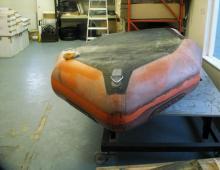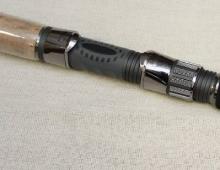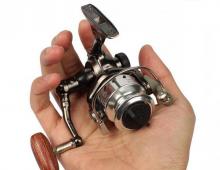Feeder fishing
The modern angler is provided with a huge selection of all kinds of gear, which makes it possible to choose the necessary equipment for any fish and reservoir. Feeder fishing is now very popular, which is associated with the ability to fish at a considerable distance from the coast and at any depth. In addition, feeder fishing is not particularly difficult, giving a chance to try yourself as a fisherman of almost any age and skill level.
What is a feeder
Feeder is an improved bottom tackle invented in England in the 1950s. The first to catch this tackle were fishermen who lived on the Severn River. The feeder arose because of the desire to fish at greater depths and further from the shore than an ordinary float rod could reach. The first 3m bamboo feeder rod was created by Richard Walker. Subsequently, the tackle has experienced a number of improvements associated with the use of new lightweight materials, the appearance of a bite signaling device, and so on.
What is the feeder tackle
Fishing tackle has a lot in common and differ in individual elements. Feeder gear consists of:
- rods;
- main line;
- coils;
- feeders;
- hooks;
- leashes;
- bite signaling device (optional);
- stands.

Rod.
Now for fishing on the feeder, rods are made of carbon or fiberglass, which have high strength and low weight. They have 3-5 knees. Length - 2-4.6 meters. Distinctive features - many access rings and a removable top, which is a bite signaling device. The rod can be equipped with tips of different stiffness (soft, medium, hard), which allows you to most conveniently adjust the gear in accordance with the weight of the feeder and bite sensitivity. It is better to purchase all types of tops. For better visibility, they have a bright color - green, red, orange.
They are classified according to the mass of the equipment. 3 main classes:
- Light (light) - equipment up to 40 g, feeder up to 30 g.
- Medium (medium) - up to 80 g, feeder up to 60 g.
- Heavy (heavy) - up to 120 g, feeder up to 90 g.
There are also additional classes - ultralight and superheavy. The latter allows you to carry equipment weighing 160 grams or more, to catch in the current of great strength and very far from the coast.
The action of the rod shows which part works (bends) when hooking. It happens:
- Slow (parabolic) - bends three quarters of the length.
- Medium (semi-parabolic) - the upper half works.
- Fast - the upper quarter or third is bent.
Depends on the class of the rod and its length. Slow and medium action are characteristic of light short rods, fast - heavy and long. According to the advice of fishermen, optimal feeder fishing involves the use of a rod 3-3.6 meters long with a fast action.
Feeder fishing on a narrow river and on a pond, where it is not possible to cast 100 meters or more, will be more convenient with a three-meter rod. There is no need to take tackle of 4 meters or more.
Main line.
Depending on the fishing conditions, monofilament and braided line can be used. Each of them has its own advantages and disadvantages.
- monofilament line. The diameter depends on the mass of the intended production, the recommended one is from 0.13 to 0.25 mm.
Advantages:
- low cost;
– good extensibility – up to 10% of the length. This feature allows you to reduce the load on the rod and reel, as the jerks of the fish are partially smoothed out by the fishing line;
- high hydrophobicity, which allows the fishing line not to swell in water and catch at sub-zero temperatures.
Flaws:
- short service life;
- easily twists in water, which accelerates the deterioration of the material and reduces the casting distance.
- Braided fishing line. The recommended diameter is from 0.11 to 0.2 mm.
Advantages:
- does not stretch, making it possible to see even a weak bite;
– high strength;
– easily comes off the spool;
– thanks to the smooth surface, it glides easily over the rings. The same feeder will fly farther on braid than on monofilament.
Flaws:
– does not absorb fish jerks, so the reel takes the main load;
- if a knot appears, then it is almost impossible to untie it;
- high price.
Tips:
- Too thick line reduces the casting distance and bends a lot in the current. A thin fishing line conveys a bite better and is less noticeable in the water.
- After each fishing, it is desirable to unwind the fishing line using a load - a spin doctor. A few casts of this load to the maximum distance will help restore the fishing line to its normal state.
Coil.
Fishing on a feeder involves the use of only spinning reels. It is better to use reels for match fishing, which have a large gear ratio and have several spools. There are several points to consider when choosing a reel to make fishing on a feeder as comfortable as possible:
- Reliability and quality - savings when buying a reel is unacceptable.
- On deep spools, thin line will fall through between the turns of already wound layers.
- A smooth ride will ensure a more uniform winding of the fishing line, as well as increase sensitivity.
- Ideally, if on a reel with a baitrunner system, which makes it possible to instantly switch the friction brake to the minimum mode for releasing the fishing line. This will help to avoid pulling the rod into the water when biting a particularly large specimen.
feeder.
Feeder gear must be equipped with a feeder. Its purpose is to bring the bait to a certain point in order to keep the fish in one place. According to the functions performed, they are divided into the following types:
- Long-range casting - front loading, which allows you to cast 40% further than usual ones of the same mass. They are shaped like a badminton shuttlecock.
- Starter feed - large feeders with large cells for accelerated leaching of feed. When touching the bottom, hooking is performed so that the bait falls out faster.
- For live bait - it is a cylinder with small holes through which the maggot, bloodworm or worm loaded inside gradually crawls out.
- Pre-feeding - used in the process of fishing, feeding the fish. They are divided as follows:
A) For stagnant water - the shape is different, the cells allow the bait to gradually erode with water.
B) For fishing on the current - the shape depends on the strength of the current on the river. A common feature is a heavy flat bottom and small cells.
Hooks.
The choice of hooks depends on the size of the fish that will be caught on the feeder, as well as the bait. Usually these are numbers from 10 to 18. The main thing is that the sting of the hook must be sharply sharpened. The smaller the hook, the less visible the rig. Made of hardened steel wire of medium thickness.
Leads.
Expensive and durable fluorocarbon fishing line with a diameter of 0.12 to 0.18 mm is suitable for leashes, which will make them invisible in the water. Length - 0.3-0.6 m. It is advisable to make a small supply of leashes in order to quickly change in the process of fishing.
Bite alarm.
It is set entirely at the request of the angler. The range is large, but electronic signaling devices are considered the best, showing a bite with a light or sound signal.
Rod stand.
Everyone chooses the most convenient option, but tripod stands are most often used.
Equipment for feeder fishing
The equipment of the feeder is quite diverse. Consists of a feeder and leashes with hooks. There are several main ways of knitting equipment:
- Paternoster (Gardner loop).
- Asymmetrical loop.
- Helicopter.
- With sliding feeder.
- With anti-twist.

- Paternoster. The simplest type of equipment.
- a small loop is knitted at the end of the main fishing line, 15 cm higher - a large one so that the feeder crawls through;
- the fishing line is passed through the rings of the rod;
- a feeder is attached to a large loop through a swivel;
- a leash with a hook is tied to a small loop (“loop to loop” or through a swivel).
- Asymmetrical loop. Suitable for extremely cautious fish.
- a swivel is put on a piece of fishing line, on which the feeder will be attached, then a loop about 0.5 m long is knitted;
- another loop is made from a large loop, 0.1-0.15 m long.
- a leash with a hook is attached to the small loop through the loop-to-loop connection;
- fixing the length of the asymmetric loop, a knot is tied;
- all equipment is connected to the main fishing line by means of a carabiner with a swivel.
Such equipment can overlap and the bite will not be visible. Therefore, a rigid fishing line is used for its installation.
- Helicopter. Not very popular due to low sensitivity. But, if the bite took place, then it means that the fish has already hooked.
- a swivel is put on a fishing line 30-40 cm long, which is fixed with silicone stoppers so that it rotates freely, but does not move along the fishing line;
- one end is attached to the main line with a swivel-carabiner connection;
- a leash with a hook is attached to the swivel;
- a feeder is attached to the free end of the fishing line. The distance from it to the swivel is easy to adjust in the process of fishing.
- With sliding feeder. A good result shows only in stagnant water.
- a stopper bead is put on a piece of fishing line 70 cm long, then a carabiner for fastening the feeder and another stopper;
- loops are knitted at the ends for attaching a leash and attaching to the main fishing line.
- The feeder slides freely between the stoppers, and the distance is easily adjusted during fishing.
- With anti-twist tube. The feeder is firmly held in place, so this rig is suitable for fishing in fast currents.
- the fishing line is threaded through the anti-twist, which is fixed with stoppers;
- a swivel for a leash is knitted at one end;
- a carabiner with a feeder is attached to the anti-twist.
The disadvantage is the unreliability of the attachment of the feeder and the large distance from it to the leash.

Feeders for feeder fishing
The feeder device involves the use of feeders. Feeding troughs are made of different materials, as well as a specific purpose. They are made from metal and plastic. The latter are good because they quickly rise from the bottom, thereby reducing the chance of catching on something. They are used on reservoirs with a cluttered or overgrown bottom.
There are the following main types of feeders:
- Spring.
- Frame.
- Mesh.
Before you equip the feeder with a feeder, you should deal with each type in more detail.
- The spring feeder is a hollow tube around which a wire is spirally twisted. The line passes through the tube, allowing the feeder to easily slide between the swivel and stopper. Differs in good flying qualities. Not suitable for fishing on the feeder in the current.
- The frame feeder is similar to a spring feeder. Instead of a spiral of wire, plastic blades are placed along the hollow tube. Bait for such a feeder should be very viscous.
- Mesh feeders ("cages") are the most common type, varying in shape, size and weight. The section can be round, triangular, square, semicircular, rectangular. Round feeders are suitable for fishing in stagnant water, the rest can be used in the current. All models have a lead weight plate, which allows them to stay firmly on the bottom. Of particular note are the square feeders, which are suitable for both flowing and still water. There are plastic and metal ones. "Cages" with forward weights are designed for very long casts.

Feeder fishing technique
Fishing on a feeder consists, in particular, in luring fish to one point and then casting bait there. The technique and tactics of fishing can be divided into several stages.
- Trial casting and determination of the fishing point. First you need to designate a landmark on the opposite bank of the reservoir. Usually it is a bush or a tree. The result of fishing will depend on the accuracy of casting the feeder tackle, so it is better to practice, trying to hit the feeder at one point.
- The study of the bottom topography. If there is no echo sounder, then depths can be measured using a weight and marker floats. You can also attach the float to the rod and cast the feeder without hooks. When the feeder touches the bottom, the float will tilt to the side.
- After casting the gear exactly to the place of fishing, the fishing line should be fixed to determine the exact distance. For this, a stopper on the spool of the reel is suitable. It is undesirable to clip the fishing line directly. Now many anglers use elastic bands (for example, bank ones), which, in turn, are fixed with a clip.
- When casting the feeder, it is necessary to avoid overlap and entanglement of the equipment. This can be achieved by keeping the rod vertical when casting. The quieter the feeder enters the water, the less the splash will scare the fish away. After immersing the feeder, you need to smoothly lower the rod forward and lay it on the stand. If the line is slack, wind it around the spool.
- Playing. As soon as a bite occurs, you must immediately remove the rod from the stand. It often happens that the fish is self-hooked and hooking from the angler is not needed. If a large specimen is caught, then it is better to exhaust the fish in a clean area, and then bring it to the shore without any problems.
For high casting accuracy, it is necessary to fix the fishing line after the rod has rested on the stand.

How to increase your catch
Each fishing method has its own secrets. Feeder fishing is no exception.
- The bait mixture must contain bait elements. In this case, the fish will approach the hook without fear.
- The place of fishing should be well fed. To do this, you need to make at least 10-15 casts of the feeder with bait. If possible, it is best to feed the fish the day before fishing.
- If the tip of the rod is hard, then the fish will feel its resistance and will not swallow the baited hook. You need to install a soft top and give a little slack to the fishing line. Its tension will serve as a bite signal.



